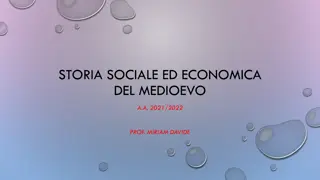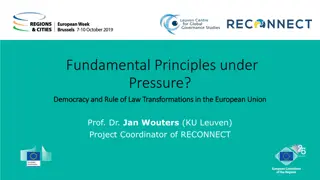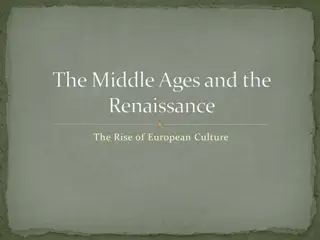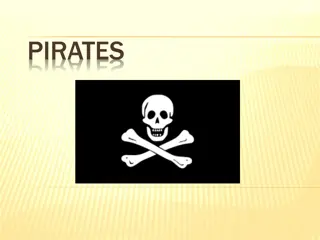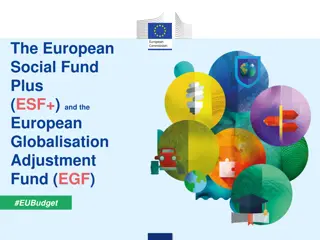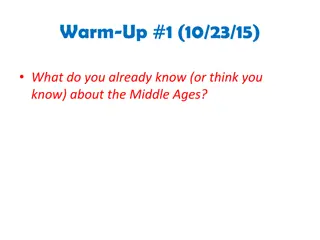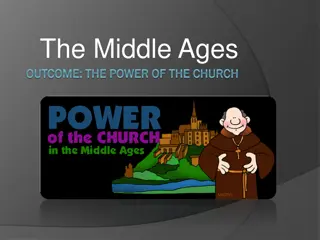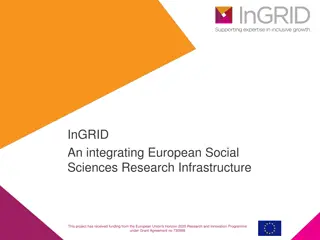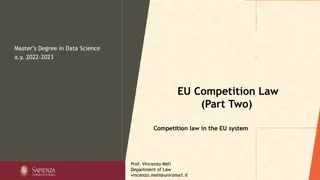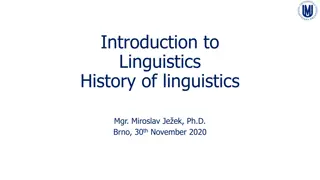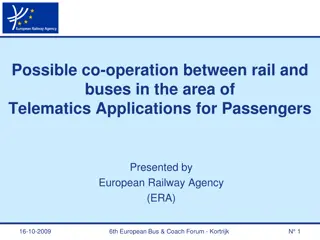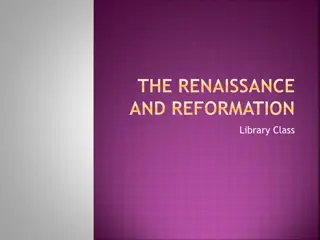Life in European Middle Ages: Social Structure and Daily Practices
The European Middle Ages witnessed a structured society with different classes such as workers, serfs, urban workers, warriors, and worshipers. Workers predominantly engaged in agricultural activities, serfs were bound to labor services and dues, urban workers faced economic challenges, warriors comprised the nobility, and worshipers played essential roles in prayer and welfare programs. Agricultural advancements, guild systems for urban workers, and feudal relationships were prominent features during this period.
Download Presentation

Please find below an Image/Link to download the presentation.
The content on the website is provided AS IS for your information and personal use only. It may not be sold, licensed, or shared on other websites without obtaining consent from the author. Download presentation by click this link. If you encounter any issues during the download, it is possible that the publisher has removed the file from their server.
E N D
Presentation Transcript
Chapter 20: The European Middle Ages, c.800-1500 HI121 Notes
The Workers 90% or more worked on fields, orchards, woodlots for a living Restricted by climate and habit for 6 months of the year in their huts - sitting about Work a communal responsibility
The Medieval Serf Peasant farmers Replaced slaves in most places Bound to perform labor services and to pay dues and taxes to their lord Worked on demesne but could use remainder of cultivable land for their use Usually hereditary due to debt but could gain freedom Had stronger bargaining power due to Black Death and need for labor
Medieval Agriculture Improvements made during this time period: Iron-tipped plow Padded horse collar from Asia The use of animal manure as fertilizer The practice of rotating portions of cultivable land that were left fallowed.
Urban Workers Craftsmen and shopkeepers top level in social status Guild system restricted competition and assured security Semiskilled Unskilled Casual laborers Lived a hand-to-mouth existence susceptible to changes in economic conditions (new trade routes) or local famines (droughts)
The Warriors European nobility that made up 2-3% of the population Patents of nobility - rights Caste: duke count marquis baron - knight Noble women were equal to noble men. Main job is to produce legitimate children for the continuity of the lineage and wealth. Not all were wealthy but land was the most meaningful Suzerain A vassal s superior person to whom service was owed Fief one or more rural villages or manor given to vassals
The Worshipers Praying for others was essential jobs of parish clergy and monks Benedictine Rule Monks and nuns believed in continual worship along with a mixture of manual and intellectual work Population of monks and nuns came from aristocracy and then middle class. Due to lack of inheritance to maintain proper lifestyle Common for church to inherit property via wills Monks and nuns supplied public welfare programs to aid aged, poor, and helpless hospitals, asylums, orphanages, hospices, schools.
The New Clerical Orders St. Francis of Assisi Italian who practiced total poverty and service to his fellows. St. Dominic Dominican Order Spaniard who wanted to convert heretics back to the true faith by showing them the error of their ways calmly and peaceably. Inquisition clerical court to bring individuals suspected of adhering to forbidden doctrines before a panel of Dominican friars who questioned their beliefs. Sometimes employed brutal methods to extract confessions.
The Economic Revival The Northern Route connected Dark Age Europe with rich markets and civilizations of the Byzantine Empire and the Abbasid Caliphate Development of new cities: Berlin, Moscow, Munich Renaissance of older sites due to Higher agriculture production Increased trade More peaceful environment: Due to Peace of God and Truce of God Crusades provided an outlet for aggressive behavior in an church approved arena The renewed application of Roman law led to the use of legal procedures as a substitute for armed action in disputes
Bourgeoisie and Jews Bourg walled settlement meant to protect life and property Bourgeoisie educated, status conscious people They were merchants, doctors, lawyers, royal and clerical officeholders Jews had come to Western Europe from the Mediterranean Jewish colonies of the Diaspora and resided in ghettos. Initially provided several of the elementary financial services in medieval cities Were prohibited from owning land or entering craft guilds so had no choice but to take up financial and mercantile pursuits
Medieval Culture and Arts The First Universities: Established in Cairo, Baghdad, and Spain to train students in the advanced Islamic sciences Specialty schools opened in other locations using Muslim model Muslims had valued and preserved and studied Greco-Roman classics since conquering the Greek lands in the East Greatest Christian teacher Thomas Aquinas. Used arguments of Aristotle to prove the existence of God and to reconcile faith and reason. Other great medieval teachers: Albertus Magnus and Peter Abelard Gothic Architecture Vernacular Literature
Disasters of the Fourteenth Century Little Ice Age The Black Death High mortality rate Decline in government revenue and trade Increased bargaining power The Hundred Years War England v. France War was bottomless pit for the French Brought prestige to English Parliament Ended chivalric ideals in combat in Europe War ceased to be personal combat between equals due to technology
Problems in the Church Babylonian Captivity popes stay in Avignon, France created scandal. Great Schism the 40 year time period when Pope Urban VI refused to step down and Clement VII was elected. Conciliar Movement laity wanted to enact some important reforms of church doctrine and the papal government. Lollards followers of John Wyclif who believe their ideas about the ability of ordinary people to interpret Scripture for themselves Council of Constance goal was to end schism, condemn Lollards, and reform church and clergy from the top to bottom
Royal Kingdoms and the Formation of States England was the forerunner under William of Normandy. Domesday Book prepared the census for tax purposes Components of modern state: Corp of royal officials, system of courts, uniform law, royal army, and a national currency. France Philip II Augustus unified and strengthened his realm Germany Investiture Controversy weakened the authority of the emperor. Another factor weakening empire was the practice of elections for the throne.
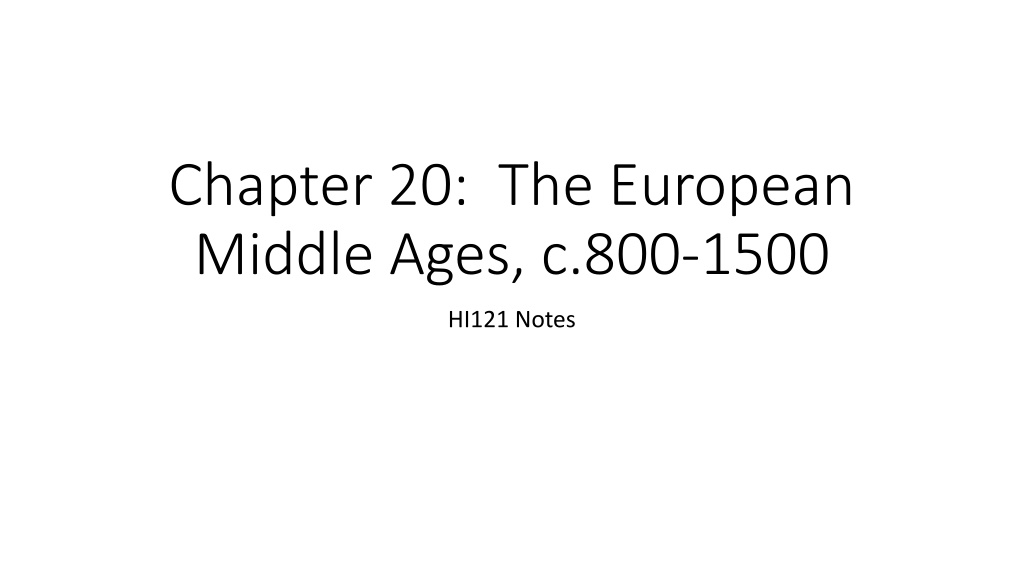


![READ⚡[PDF]✔ European Mail Armour: Ringed Battle Shirts from the Iron Age, Roman](/thumb/20552/read-pdf-european-mail-armour-ringed-battle-shirts-from-the-iron-age-roman.jpg)
